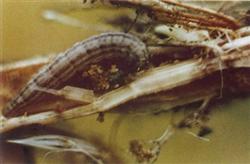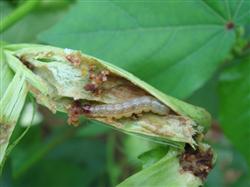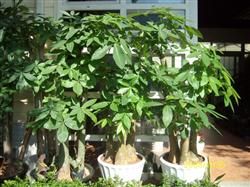What is rice stem borer and how to control it?

What is rice stem borer and how to control it? Please introduce and control the rice stem borer, Chilo suppressalis. It is distributed in the rice areas of southern and northern China. Host rice, corn, sugar cane, millet, broad bean, Zizania caduciflora, sorghum, rape, wheat, Ziyunying and so on. The damage caused by the pest is still serious in recent years. The damage characteristics of rice showed withered heart seedlings and withered sheaths at tillering stage, withered pregnant ears and white ears at booting stage and heading stage, semi-withered ears and insect-injured plants at filling stage and milk stage, and increased blighted grains, which were easy to turn back in case of strong wind. For the withered heart seedlings caused by Chilo suppressalis, the larvae first gather to feed on the inside of the leaf sheath, the water-stained macula appears outside the leaf sheath, the later leaf sheath is withered and yellow, and the leaves gradually die, which is called the withered shoot stage. After the larvae got into the rice stem, the tip of the sword leaf turned yellow, the serious heart leaf withered and died, there were wormholes in the injured stem, there were few insect feces outside the hole, there were many insect feces in the stem, yellow and the rice straw was easy to break. Different from the withered seedlings caused by Chilo suppressalis and Chilo suppressalis. The morphological characteristics of the female moth are 14-16.5mm in length, 23-26mm in wingspan, filiform antennae, gray-yellow forewings, nearly oblong, 7 small black spots along the outer edge, white hind wings and gray-white spindle-shaped abdomen. The male moth has a length of 13-15mm, a wingspan of 21-23mm, a black spot in the center of the forewing, three small black spots below, and a thin cylinder-shaped abdomen. Eggs long 1.2mm, oblate oval, egg blocks from tens to 200 arranged into fish scales, long 13-16mm, wide 3mm, milky white to yellowish white or grayish brown. The larvae are about the 6th instar. The body length of the last instar larvae is 20-30mm, and the head is reddish brown except the upper collar, all light brown, with reddish brown stripes. The pupa is 10-13mm long, beige to light yellowish brown or brown. There are 4 generations in district 3, 5 generations in 20 ℃ 24 ℃ and 5 generations in 24 Mel, which is higher than that in 24 Mel. The 4th instar larvae overwintered in rice stump, straw or other host stems, weeds, soil crevices and so on. Pupation began when the temperature was higher than 11 ℃, and adults emerged at 15 ℃. Most of the larvae below the 4th instar entered the upper rice stump and the stems of winter crops such as wheat, barley, broad bean, rape and so on when the soil temperature was higher than 7 ℃ in the following year, and the average temperature of 10 ℃ entered the peak stage of transfer, and then continued to feed on the inner wall of the winter crop, and when they matured, they bit an Eclosion hole in the inner wall of the host, leaving only the epidermis and drilling out of the membrane after Eclosion. It has phototaxis and likes to lay eggs on seedling leaves, and round culms produce on leaf sheaths with wide leaves, thick culms and green growth after jointing; the newly hatched larvae first drill into the leaf sheath and cause withered sheath, and then drill into the stem after the 2nd and 3rd instar, and turn into the plant after the 3rd instar. The insect has strong vitality, miscellaneous feeding habits and tolerance to drought, humidity and low temperature. The main natural enemies are egg parasitoids and so on. Click to get more pesticide application techniques
- Prev

What are the reasons for the occurrence of corn borer?
What are the reasons for the occurrence of corn borer? Please introduce the reasons for the occurrence of corn borer as follows: (1) population base: the population base of the previous generation is an important factor affecting the severity of corn borer damage. The number of insect population is large, which often causes serious damage under suitable environmental conditions. ...
- Next

How to raise a rich tree?
How to raise a rich tree? Please introduce Malama chestnut, also known as melon chestnut, rich tree. It is a small evergreen tree of the kapok family. Originally from Mexico, Costa Rica. Leaves palmate, leaflets 7-11, oblong to Obovate. There are horticultural varieties, flowers and leaves, rich trees. Because the name of the fortune tree is very popular with businessmen and the general public.
Related
- Fuxing push coffee new agricultural production and marketing class: lack of small-scale processing plants
- Jujube rice field leisure farm deep ploughing Yilan for five years to create a space for organic food and play
- Nongyu Farm-A trial of organic papaya for brave women with advanced technology
- Four points for attention in the prevention and control of diseases and insect pests of edible fungi
- How to add nutrient solution to Edible Fungi
- Is there any good way to control edible fungus mites?
- Open Inoculation Technology of Edible Fungi
- Is there any clever way to use fertilizer for edible fungus in winter?
- What agents are used to kill the pathogens of edible fungi in the mushroom shed?
- Rapid drying of Edible Fungi

